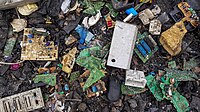
Photo from wikipedia
Heavy metals generated from e-waste have created serious health risks for residents in e-waste disposal areas. This study assessed how airborne toxic metals from an e-waste dismantling park (EP) influenced… Click to show full abstract
Heavy metals generated from e-waste have created serious health risks for residents in e-waste disposal areas. This study assessed how airborne toxic metals from an e-waste dismantling park (EP) influenced surrounding residential areas after e-waste control. PM2.5, PM10, and total suspended particles (TSP) were sampled from 20 sites, including an EP, residential areas, and an urban site; ten kinds of metals were analyzed using ICP-MS and classified as PM2.5, PM2.5–10, and PM10–100. Results showed that metals at the EP tended to be in coarser particles, while metals from residential areas tended to be in finer particles. A source analysis showed that metals from the EP and residential areas may have different sources. Workers’ cancer and non-cancer risks were higher when exposed to PM2.5–10 metals, while residents’ risks were higher when exposed to PM2.5 metals. As and Cr were the most strongly associated with cancer risks, while Mn was the most strongly associated with the non-cancer risk. Both workers and residents had cancer risks (>1.0 × 10−6), but risks were lower for residents. Therefore, e-waste control can positively affect public health in this area. This study provides a basis for further controlling heavy metal emissions into the atmosphere by e-waste dismantling and encouraging worldwide standardization of e-waste dismantling.
Journal Title: International Journal of Environmental Research and Public Health
Year Published: 2022
Link to full text (if available)
Share on Social Media: Sign Up to like & get
recommendations!